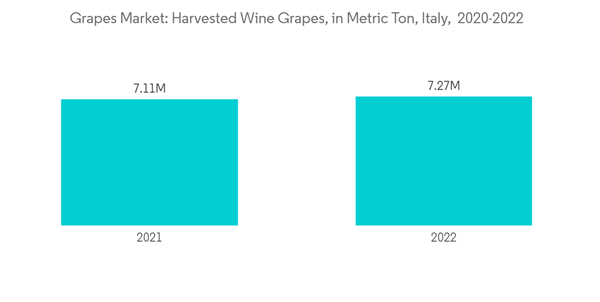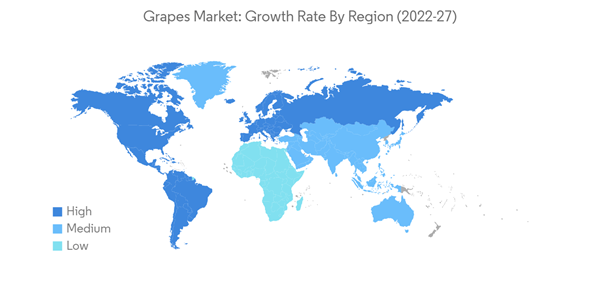Key Highlights
- Grapes are one of the largest fruit crops, and table grapes are one of the major types of grapes grown worldwide, which are the fresh-consumed grapes. According to the International Organization of Viticulture and Oenology (IOVE), the world's vineyard area has stabilized at 9.5-10.0 million hectares, and grape production has consistently increased to 60-70 million metric tons per year in recent years. Almost 80-90% of the total volume of grapes produced in the world is used for processing and manufacturing wine, juices, and other goods, while up to 10% is consumed fresh and the remaining 5-6% is used for drying.
- The demand for table grapes is growing globally, particularly in Asia-Pacific, the Middle East, and Russia. As per the Food and Agriculture Organization, the global production of fresh grapes, including table grapes, reached 78.03 million metric tons in 2020, which has increased from 77.00 million metric tons in 2019. Hence, increased production is anticipated to create an attractive market for grape growers globally due to the increased demand from various consumers.
Grape Market Trends
The Growth of the Global Wine Industry is Driving the Grapes Market
Grapes are used for wine production, and with the increasing demand for wine, the demand for grapes is also increasing. Because they have more people, the United States, Italy, China, and France have the largest markets for wine as a whole.In Europe, the wine industries have immense demand as well as potential. Italy is one of the world's oldest wine-producing countries. The country has an immense wealth of experience, diversity (over 2,000 grape varieties and vintages), and some of the world's finest wines. France has approximately 400 varieties, of which hardly 100 are grown extensively, while many growers are looking to grow forgotten varieties to combat climate change. In recent decades, the Italian and French wine supply chains have performed well in terms of profitability and performance in both home and foreign markets. Even though it is fragmented in terms of products, prices, and consumption context, and, in particular, even though it is characterized by an organization that prevents full utilization of economies of scale, it has made the industry highly competitive, increasing the potential for tourism and value addition while also pushing for the best quality of wines to serve the growing market.
North America Dominates the Market
Mexico remains the largest supplier of grapes in North America, and most of the production in the country gets shipped to the United States and Canada. The majority of the imported grapes in North America are used for manufacturing wines. There are many different grape varieties, each with its own unique characteristics in terms of form, growth, suitability for different climates and regions, and winemaking features. Some of the varieties typically used for wines are Chardonnay, Sauvignon Blanc, Riesling, Muscat, Malbec, Pinot Noir, etc.The United States is the largest importer of grapes in the world. The major countries from which the United States imports grapes include Chile, Mexico, and Peru, which together account for almost 99% of American grape imports. In Canada as well, grape production is limited, so most of the fresh table grapes are imported from the United States, Mexico, and Chile. Winemaking is one of Canada's highest value-added agricultural products, as it has more than 670 wineries in the country, generating high-quality wines and major economic advantages.
The United States is a growing market for wines, with domestic demand exceeding wine production in the country. Almost all 50 states in the United States produce wine; however, California and Washington produce the majority of the country's wine. The United States' geological and climatic conditions have provided these states with favorable grape-growing conditions, such as higher altitude continental climes or coastal fog-laden areas, which are expected to drive the market.
Additional Benefits:
- The market estimate (ME) sheet in Excel format
- 3 months of analyst support
This product will be delivered within 2 business days.










